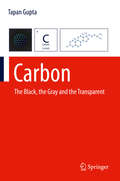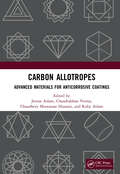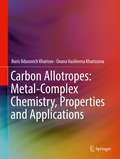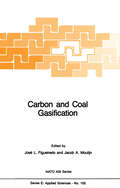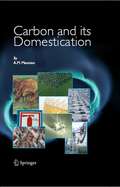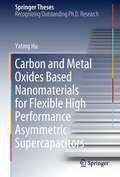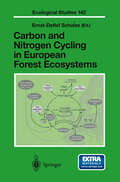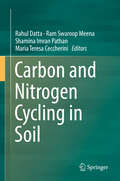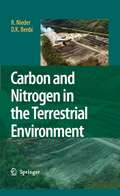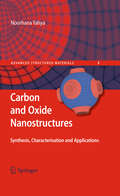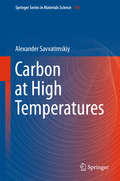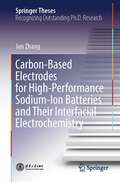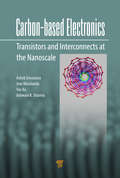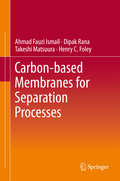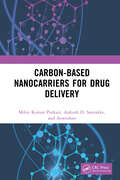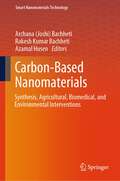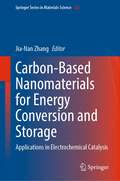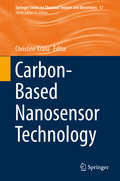- Table View
- List View
Carbohydrates- Iodine Test (tactile)
by Sheffield Vi ServiceThis is a diagram of the chemical test for the presence of carbohydrates. It has leader lines pointing to parts of the equipment, which can be labelled.
Carbon: The Black, the Gray and the Transparent
by Tapan GuptaAll living things contain carbon in some form, as it is the primary component of macromolecules including proteins, lipids, nucleic acids (RNA and DNA), and carbohydrates. As a matter of fact, it is the backbone of all organic (chemistry) compounds forming different kinds of bonds. Carbon: The Black, the Gray and the Transparent is not a complete scientific history of the material, but a book that describes key discoveries about this old faithful element while encouraging broader perspectives and approaches to its research due to its vast applications. All allotropes of carbon are described in this book, along with their properties, uses, and methods of procurement or manufacturing. Black carbon is represented by coal, gray carbon is represented by graphite, and transparent carbon is represented by diamond.
Carbon: A Biography
by Sacha Loeve Bernadette Bensaude-VincentCarbon is much more than a chemical element: it is a polymorphic entity with many faces, at once natural, cultural and social. Ranging across ten million different compounds, carbon has as many personas in nature as it has roles in human life on earth. And yet it rarely makes the headlines as anything other than the villain of our fossil-based economy, feeding an addiction which is driving dangerous levels of consumption and international conflict and which, left unchecked, could lead to our demise as a species. But the impact of CO₂ on climate change only tells part of the story, and to demonize carbon as an element which will bring about the downfall of humanity is to reduce it to a pale shadow of itself. In this major new history of carbon, Bernadette Bensaude-Vincent and Sacha Loeve show that this omnipresent element is at the root of countless histories and adventures through time, thanks to its extraordinary versatility. Carbon has a long and prestigious CV: its work and achievements extend far beyond the burning of fossil fuels. The fourth most abundant element in the universe and the second most abundant element in the human body, carbon is the chemical basis of all known life. Carbon chemistry has a long history, with applications ranging from jewellery to heating, underpinning developments in metallurgy, textiles, pharmaceuticals, electronics, nanoscience and green technologies. A biography of carbon transgresses the boundaries between chemical and social existence, between nature and culture, forcing us to abandon the simplified image of carbon as the anti-hero of human civilization and enabling us to see instead the great diversity of carbon’s modes of existence. With scientific precision and literary flair, Bensaude-Vincent and Loeve unravel the surprising ways in which carbon has shaped our world, showing how unrecognizable the earth would be without it. Uncovering the many hidden lives of carbon allows us to view our own with fresh eyes.
Carbon-13 NMR Shift Assignments of Amines and Alkaloids
by M. ShammaThe aim of this book is to gather under one cover most of the data presently available on the carbon-13 nuclear magnetic resonance (cmr) spectra of alkaloids. The term "alkaloids" is used here in a very broad sense to include synthetic analogues of the natural products. Simple model amines are also incorporated since these often supply the basic information required in the assignment of chemical shifts for the more complex compounds. The literature on alkaloid cmr spectroscopy has been covered through 1977, but the collec tion of compounds presented here is illustrative rather than exhaustive. The papers included in the reference list afford further information not only on the cmr assignments of the particular compounds provided here, but also incorporate data on additional related structures. Only a few dimeric indole alkaloids are included since to a large extent their cmr spectra can be corre lated directly with those of their monomeric analogues. The present volume is thus a representative empirical compendium of cmr assignments focusing upon alkaloids and model amines, and is intended to aid cmr research in heterocyclic and alkaloid chemistry. The compounds and data presented in this book are classified and organized according to structural similarity. The purpose of such a presenta tion is to demonstrate the common cmr characteristics of a given structural type, while also facilitating an empirical evaluation of the cmr spectral changes specifically reSUlting from relatively minor variations in oxidation level, substitution, or stereochemistry.
Carbon-13 NMR Spectral Problems (Organic Chemistry)
by Robert B. Bates William A. BeaversWith the advent of Fourier transform spectrometers of great sensitivity, it has become practical to obtain carbon-13 nuclear magnetic resonance (C-13 NMR; l3C NMR; CMR) spectra routinely on organic molecules, and this technique has become one of the highest utility in determining structures of organic unknowns. When the usual spectrometric techniques proton magnetic resonance (H-I NMR; IH NMR; PMR), infrared (lR), mass (MS), and ultraviolet (UV)-do not readily reveal a compound's structure, a C-13 NMR spectrum will often provide sufficient additional information to yield it unequivocally. With this in mind, the present work was designed to give advanced undergraduates, graduate students, and practicing chemists a working knowledge of and facility with the use of this valuable technique. Some familiarity with other spectrometric techniques is assumed (recommended book: Silverstein, Bassler, and Morrill, Spectrometric Identification of Organic Compounds), but no prior knowledge of C-13 NMR -which is treated very lightly, if at all, in the widely used elementary organic texts-is necessary. A discussion of C-13 NMR spectroscopy is followed by 125 problems, each consisting of a molecular formula, two types of C-13 NMR spectra (partially and completely proton decoupled, with connecting lines to facilitate multiplicity assignments), an integrated H-I NMR spectrum, and the most important IR, UV, and MS data. These problems have been very carefully prepared, thoroughly tested by students at the University of Arizona, and we believe that very few errors remain.
Carbon Allotropes: Advanced Materials for Anticorrosive Coatings
by Jeenat Aslam Chandrabhan Verma Chaudhery Mustansar Hussain Ruby AslamThe study of corrosion-resistant coatings using nanostructured materials is developing and growing at a very rapid rate. Carbon Allotropes: Advanced Anticorrosive Coatings Materials summarizes current research and technology on the significance of carbon allotropes in anticorrosive coatings. The book describes the synthesis, characterization, inhibitory mechanism, and industrial applications of carbon allotropes as a corrosion-resistant coating. The usage of carbon allotropes as nanostructure materials based on corrosion-resistant coatings used in contemporary industrial platforms is discussed in this book. Additionally, this book assesses the potential of carbon allotropes as the foundation for corrosion-resistant nanostructure materials and coatings. For scientists and engineers looking for cutting-edge ideas for nanostructures based on carbon allotropes as corrosion-resistant coating materials, this book is an invaluable resource. Salient Features This book covers nanostructured carbon allotropes as materials for corrosion-resistant coatings. The use of carbon allotropes as anticorrosive has revolutionized modern industrial practices. This offers academics and entrepreneurs an influential foundational, interdisciplinary, and primary literature reading. The most cutting-edge coatings based on carbon allotropes are also highlighted, along with current manufacturing and operating challenges. This maintains ongoing research on corrosion-resistant coatings using nanostructured materials while incorporating fresh advancements across the entire area.
Carbon Allotropes: Metal-Complex Chemistry, Properties and Applications
by Boris Ildusovich Kharisov Oxana Vasilievna KharissovaThis book provides a detailed description of metal-complex functionalized carbon allotrope forms, including classic (such as graphite), rare (such as M- or T-carbon), and nanoforms (such as carbon nanotubes, nanodiamonds, etc.). Filling a void in the nanotechnology literature, the book presents chapters generalizing the synthesis, structure, properties, and applications of all known carbon allotropes. Metal-complex composites of carbons are described, along with several examples of their preparation and characterization, soluble metal-complex carbon composites, cost-benefit data, metal complexes as precursors of carbon allotropes, and applications. A lab manual on the synthesis and characterization of carbon allotropes and their metal-complex composites is included.Provides a complete description of all carbon allotropes, both classic and rare, as well as carbon nanostructures and their metal-complex composites;Contains a laboratory manual of experiments on the synthesis and characterization of metal-complex carbon composites;Discusses applications in diverse fields, such as catalysis on supporting materials, water treatment, sensors, drug delivery, and devices.
Carbon Allotropes: Advanced Materials for Anticorrosive Coatings
The study of corrosion-resistant coatings using nanostructured materials is developing and growing at a very rapid rate. Carbon Allotropes: Advanced Anticorrosive Coatings Materials summarizes current research and technology on the significance of carbon allotropes in anticorrosive coatings. The book describes the synthesis, characterization, inhibitory mechanism, and industrial applications of carbon allotropes as a corrosion-resistant coating. The usage of carbon allotropes as nanostructure materials based on corrosion-resistant coatings used in contemporary industrial platforms is discussed in this book. Additionally, this book assesses the potential of carbon allotropes as the foundation for corrosion-resistant nanostructure materials and coatings. For scientists and engineers looking for cutting-edge ideas for nanostructures based on carbon allotropes as corrosion-resistant coating materials, this book is an invaluable resource. Salient Features This book covers nanostructured carbon allotropes as materials for corrosion-resistant coatings. The use of carbon allotropes as anticorrosive has revolutionized modern industrial practices. This offers academics and entrepreneurs an influential foundational, interdisciplinary, and primary literature reading. The most cutting-edge coatings based on carbon allotropes are also highlighted, along with current manufacturing and operating challenges. This maintains ongoing research on corrosion-resistant coatings using nanostructured materials while incorporating fresh advancements across the entire area.
Carbon and Coal Gasification: Science and Technology (NATO Science Series E: #105)
by J. L. Figueiredo Jacob A. MoulijnCarbon gasification reactions form the basis of many important industrial processes, such as the combustion of coal and the produc tion of synthesis gas, fuel gases and activated carbons. They are also involved in metallurgical processes and in the regeneration of coked catalysts. Thus, understanding the fundamentals of carbon gasification is of vital importance for further technological development. Moreover, the subject is of interdisciplinary nature, involving chemistry, ma terials science and chemical engineering. Therefore, it was thought that an Advanced Study Institute would be fruitful in establishing the state of the art, in bringing together experts from the various sectors involved and in identifying areas of required research and industrial development. Such a meeting was held at Alvor, Portugal, from the 20th to the 31st May 1985, and the lectures presented the reof are collected in this volume. The present volume is organized in seven chapters. The Intro duction presents the carbon gasification reactions an~ their rele vance for particular processes and industrial uses. In the second chapter, the structures of carbon and coal are reviewed, together with methods of structural, chemical and textural characterization.
Carbon and Its Domestication
by A.M. MannionCarbon is a vital component of environmental and economic systems. Its unique chemistry makes it important biologically, geologically, and climatically. Its domestication in time and space has many manifestations, including the control of fire, development of agriculture, fossil-fuel use and biotechnology. All have exacted an environmental price. Many agencies exist to manage carbon through conservation, etc. Carbon management is now a highly charged international political issue in which energy provision is a primary factor. This cross-disciplinary text focuses on the pivotal role of carbon in society and in the environment.
Carbon and Metal Oxides Based Nanomaterials for Flexible High Performance Asymmetric Supercapacitors (Springer Theses)
by Yating HuThis thesis examines electrode materials such as mesoporous carbons, manganese oxides, iron oxides and their nanohybrids with graphene. It also explores several of the key scientific issues that act as the governing principles for future development of supercapacitors, which are a promising class of high-efficiency energy storage devices for tackling a key aspect of the energy crisis. However, critical technical issues, such as the low energy density and reliability, need to be addressed before they can be extended to a wide range of applications with much improved performance. Currently available material candidates for the electrodes all have their disadvantages, such as a low specific capacitance or poor conductivity for transition metal oxide/hydroxide-based materials. This thesis addresses these important issues, and develops a high-performance, flexible asymmetric supercapacitor with manganese oxides/reduced graphene oxide as the positive electrode and iron oxide/reduced graphene oxide as the anode, which delivers a high energy density of 0.056 Wh cm-3.
Carbon and Nitrogen Cycling in European Forest Ecosystems (Ecological Studies #142)
by Ernst-Detlef SchulzeThis volume quantifies carbon storage in managed forest ecosystems not only in biomass, but also in all soil compartments. It investigates the interaction between the carbon and nitrogen cycles by working along a north-south transect through Europe that starts in northern Sweden, passes through a N-deposition maximum in central Europe and ends in Italy. For the first time biogeochemical processes are linked to biodiversity on a large geographic scale and with special focus on soil organisms. The accompanying CD-ROM provides a complete database of all flux, storage and species observations for modellers.
Carbon and Nitrogen Cycling in Soil
by Rahul Datta Ram Swaroop Meena Shamina Imran Pathan Maria Teresa CeccheriniSeveral textbooks and edited volumes are currently available on general soil fertility but‚ to date‚ none have been dedicated to the study of “Sustainable Carbon and Nitrogen Cycling in Soil.” Yet this aspect is extremely important, considering the fact that the soil, as the ‘epidermis of the Earth’ (geodermis)‚ is a major component of the terrestrial biosphere. This book addresses virtually every aspect of C and N cycling, including: general concepts on the diversity of microorganisms and management practices for soil, the function of soil’s structure-function-ecosystem, the evolving role of C and N, cutting-edge methods used in soil microbial ecological studies, rhizosphere microflora, the role of organic matter (OM) in agricultural productivity, C and N transformation in soil, biological nitrogen fixation (BNF) and its genetics, plant-growth-promoting rhizobacteria (PGPRs), PGPRs and their role in sustainable agriculture, organic agriculture, etc. The book’s main objectives are: (1) to explain in detail the role of C and N cycling in sustaining agricultural productivity and its importance to sustainable soil management; (2) to show readers how to restore soil health with C and N; and (3) to help them understand the matching of C and N cycling rules from a climatic perspective.Given its scope, the book offers a valuable resource for educators, researchers, and policymakers, as well as undergraduate and graduate students of soil science, soil microbiology, agronomy, ecology, and the environmental sciences. Gathering cutting-edge contributions from internationally respected researchers, it offers authoritative content on a broad range of topics, which is supplemented by a wealth of data, tables, figures, and photographs. Moreover, it provides a roadmap for sustainable approaches to food and nutritional security, and to soil sustainability in agricultural systems, based on C and N cycling in soil systems.
Carbon and Nitrogen in the Terrestrial Environment
by R. Nieder D.K. BenbiCarbon and Nitrogen in the Terrestrial Environment is a comprehensive, interdisciplinary description of C and N fluxes between the atmosphere and the terrestrial biosphere; issues related to C and N management in different ecosystems and their implications for the environment and global climate change; and the approaches to mitigate emission of greenhouse gases. Drawing upon the most up-to-date books, journals, bulletins, reports, symposia proceedings and internet sources documenting interrelationships between different aspects of C and N cycling in the terrestrial environment, Carbon and Nitrogen in the Terrestrial Environment fills the gap left by most of the currently available books on C and N cycling. They either deal with a single element of an ecosystem, or are related to one or a few selected aspects like soil organic matter (SOM) and agricultural or forest management, emission of greenhouse gases, global climate change or modeling of SOM dynamics.
Carbon and Oxide Nanostructures: Synthesis, Characterisation and Applications (Advanced Structured Materials #5)
by Noorhana YahyaThis volume covers all aspects of carbon and oxide based nanostructured materials. The topics include synthesis, characterization and application of carbon-based namely carbon nanotubes, carbon nanofibres, fullerenes, carbon filled composites etc. In addition, metal oxides namely, ZnO, TiO2, Fe2O3, ferrites, garnets etc., for various applications like sensors, solar cells, transformers, antennas, catalysts, batteries, lubricants, are presented. The book also includes the modeling of oxide and carbon based nanomaterials. The book covers the topics: Synthesis, characterization and application of carbon nanotubes, carbon nanofibres, fullerenes Synthesis, characterization and application of oxide based nanomaterials. Nanostructured magnetic and electric materials and their applications. Nanostructured materials for petro-chemical industry. Oxide and carbon based thin films for electronics and sustainable energy. Theory, calculations and modeling of nanostructured materials.
Carbon at High Temperatures (Springer Series in Materials Science #134)
by Alexander SavvatimskiyThis book deals with the properties and behavior of carbon at high temperatures. It presents new methods and new ways to obtain the liquid phase of carbon. Melting of graphite and the properties of liquid carbon are presented under stationary heat and pulse methods. Metal like properties of molten graphite at high initial density are indicated. A new possible transition of liquid carbon from metal to nonmetal behavior much above the melting point is mentioned. Methodical questions of pulse heating, in particular the role of pinch-pressure in receiving a liquid state of carbon, are discussed. The reader finds evidence about the necessity of applying high pressure (higher than 100 bar) to melt graphite (melting temperature 4800±100 K). The reader can verify the advantage of volume pulse electrical heating before surface laser heating to study the physical properties of carbon, including enthalpy, heat capacity, electrical resistivity and temperature. The advantages of fast heating of graphite by pulsed electric current during a few microseconds are shown. The data obtained for the heat capacity of liquid carbon under constant pressure and constant volume were used to estimate the behavior at temperatures much higher 5000 K.
Carbon-Based Electrodes for High-Performance Sodium-Ion Batteries and Their Interfacial Electrochemistry (Springer Theses)
by Jun ZhangThis book focuses on the development of high-performance carbon electrodes for sodium ion batteries (SIBs). By proposing folded-graphene as the high-density cathode with excellent rate capability, it provides insight into the interplay between oxygen functional groups and folded texture. It also highlights the superiority of ether electrolytes matching with carbon anodes, which are shown to deliver largely improved electrochemical performance. The achievements presented offer a valuable contribution to the carbon-based electrodes in SIBs.
Carbon-Based Electronics: Transistors and Interconnects at the Nanoscale
by Ashok Srivastava Jose Mauricio Marulanda Yao Xu Ashwani SharmaDiscovery of one-dimensional material carbon nanotubes in 1991 by the Japanese physicist Dr. Sumio Iijima has resulted in voluminous research in the field of carbon nanotubes for numerous applications, including possible replacement of silicon used in the fabrication of CMOS chips. One interesting feature of carbon nanotubes is that these can be me
Carbon-based Membranes for Separation Processes
by Ahmad Fauzi Ismail Dipak Rana Takeshi Matsuura Henry C. FoleyThis book provides a significant overview of carbon-related membranes. It will cover the development of carbon related membranes and membrane modules from its onset to the latest research on carbon mixed matrix membranes. After reviewing progress in the field, the authors indicate future research directions and prospective development. The authors also attempt to provide a guideline for the readers who would like to establish their own laboratories for carbon membrane research. For this purpose, detailed information on preparation, characterization and testing of various types of carbon membrane is provided. Design and construction of carbon membrane modules are also described in detail.
Carbon-Based Nanocarriers for Drug Delivery
by Mihir Kumar Purkait Ankush D. Sontakke AnweshanCarbon-Based Nanocarriers for Drug Delivery enlists the latitudes and advancements in the synthesis processes, functionalization, and applications of carbon-based nanomaterials (CBNs) in targeted drug delivery systems (DDSs). It covers the applicability and suitability of CBNs as nanocarriers for efficient drug delivery application via elucidating the recent advancements in CBNs, their functionalized and innovative derivatives, and the relevant case studies. The book explores the necessity, efficacy, toxicological aspects, and challenges for the application of CBN in targeted DDSs. Some of the features of this book are provided as follows: Provides elaborative description on significance and adaptability of carbon-based nanomaterial in targeted drug delivery for wide ranges of therapeutics Delivers a full-spectrum discussion on drug delivery through carbon-based nanocarriers Explores each carbon-based nanocarrier fundamentally for its drug and gene-delivery-related applications Describes critical discussion on various toxicological effects over the utilization of these nanocarriers Embraces existing as well as novel technologies/methodologies related to the synthesis and functionalization of CBNs, including graphene, graphene oxide, carbon quantum dots, carbon nanotube, fullerene, and smart carbon-based nanocarriers This book is aimed at researchers and graduate students in materials and pharmaceutical engineering, including drug delivery systems.
Carbon-Based Nanocarriers for Drug Delivery
by Mihir Kumar Purkait Ankush D. Sontakke AnweshanCarbon-Based Nanocarriers for Drug Delivery enlists the latitudes and advancements in the synthesis processes, functionalization, and applications of carbon-based nanomaterials (CBNs) in targeted drug delivery systems (DDSs). It covers the applicability and suitability of CBNs as nanocarriers for efficient drug delivery application via elucidating the recent advancements in CBNs, their functionalized and innovative derivatives, and the relevant case studies. The book explores the necessity, efficacy, toxicological aspects, and challenges for the application of CBN in targeted DDSs. Some of the features of this book are provided as follows: Provides elaborative description on significance and adaptability of carbon-based nanomaterial in targeted drug delivery for wide ranges of therapeutics Delivers a full-spectrum discussion on drug delivery through carbon-based nanocarriers Explores each carbon-based nanocarrier fundamentally for its drug and gene-delivery-related applications Describes critical discussion on various toxicological effects over the utilization of these nanocarriers Embraces existing as well as novel technologies/methodologies related to the synthesis and functionalization of CBNs, including graphene, graphene oxide, carbon quantum dots, carbon nanotube, fullerene, and smart carbon-based nanocarriers This book is aimed at researchers and graduate students in materials and pharmaceutical engineering, including drug delivery systems.
Carbon-Based Nanomaterials: Synthesis, Agricultural, Biomedical, and Environmental Interventions (Smart Nanomaterials Technology)
by Archana Joshi Bachheti Rakesh Kumar Bachheti Azamal HusenCarbon nanomaterials have several applications, which is driving up scientific research into them. The book showcases the most recent advancements and research discoveries rather than just providing an overview. Each chapter offers authoritative insights into the ever-changing field of carbon-based nanomaterials, as written by top authorities in their respective domains. The book stands out for its persistent focus on real-world application. It is devoted to practical applications and is divided into four sections. The intriguing promise of carbon nanomaterials, their synthesis, and their possible uses set the stage for the adventure. Subsequently, the emphasis shifts to agriculture, where nanomaterials have been shown to improve plant health, fend against illnesses, promote growth and development, and even help detect and remove herbicides. The biomedical part explores the potential toxicological ramifications of these materials while introducing the reader to their ground-breaking role in drug delivery, tissue engineering, and the fight against fungal diseases. Overall, the book provides valuable insights and serves as a comprehensive resource for researchers and scientists across various interdisciplinary subjects.
Carbon-Based Nanomaterials for Energy Conversion and Storage: Applications in Electrochemical Catalysis (Springer Series in Materials Science #325)
by Jia-Nan ZhangThis book systematically summarizes the advanced development of carbon-based nanomaterials for electrochemical catalysis, and it is comprised of four sections. The first section discusses about the fundamental synthesis, characterization techniques, and catalytic effects on the energy conversion and storage mechanism. The second section elaborately reviews various types of electrocatalytic reactions on carbon-based materials and their performance. The third section focuses on batteries about carbon-based materials with different storage mechanism. And the last one, the following enlightenment in terms of theoretical development and experimental research is provided to the general readers: 1) Precise design and construction of local atomic and electronic structures at the interface of catalysts; 2) Selective activation and directed conversion of carbon-based energy-carrying molecules at the interface; 3) Interaction mechanism and regulation of catalyst solid surface interface properties under environment and external field. This book will be useful for researchers and students who are interested in carbon-based nanomaterials, electrochemical catalysts and energy storage.
Carbon-Based Nanomaterials for Environmental Applications (Engineering Materials)
by Muhammad Ikram Ali Haider Sawaira Moeen Junaid HaiderThis book delves into the incredible potential of carbon-based nanomaterials to solve critical ecological problems. Over the last few decades, substantial research has been conducted on the design and development of advanced nanomaterials for efficient energy storage, wastewater treatment, and antibacterial activities. Carbon-based materials have drawn increasing attention owing to their intriguing physicochemical properties and broad range of promising applications. Learn how these innovative materials are transforming our planet for improvements in areas as diverse as pollution management, purging water, and renewable energy. In this book, the authors briefly introduce the classification of carbon-based materials followed by describing in detail the various synthetic methods classified in two categories, i.e., bottom-up methods and top-down methods. After introducing the synthesis, environmental applications including water purification, air purification, and energy storage and antibacterial activity are explained. Finally, the challenges and opportunities in this promising research area are also proposed. In the current book, carbon-based nanomaterials are addressed in aim for sufficient energy production, wastewater treatment, and as an antibacterial agent. In Chapters 1 and 2, the authors overview the introduction and classifications of carbon-based nanomaterials with its fabrication process. In the next section, the authors review the water purification applications and improvement in the dye degradation activity of carbon-based materials including doping, increasing surface area, and many others. Chapter 4 covers the air purification and energy applications of carbon-based materials along with their experimental and theoretical studies. Moreover, the next chapter explores carbon-based materials for antibacterial activity. This book is specially designed for research purposes and helps the beginners, post-graduate students, and experienced researchers who are working on carbon-based materials and their applications. The book sheds critical light on the ways in which these materials might help make the world a better, more sustainable place.
Carbon-Based Nanosensor Technology (Springer Series on Chemical Sensors and Biosensors #17)
by Christine KranzCarbon nanomaterials have gained relevance in chem/bio sensing applications owing to their unique chemical, mechanical, electrical, and thermal characteristics. Written by leading experts in the field, this book discusses selected, state-of-the art carbon-based nanomaterials, including nanodiamonds, graphene nanodots, carbon nanopores, and nanocellulose. It presents examples of chem/bio sensing applications ranging from biomedical studies, such as DNA sequencing and neurotransmitter sensing, to heavy-metal detection in environmental monitoring scenarios, and reviews the unique properties of carbon-based nanomaterials with respect to targeted sensing applications. Further, it highlights exciting future applications. Providing comprehensive information for practitioners and scientists working in the field of carbon nanomaterial technologies and their application, it is also a valuable resource for advanced students of analytical chemistry, biochemistry, electrochemistry, materials science, and micro-/nanotechnology and -sensing.

